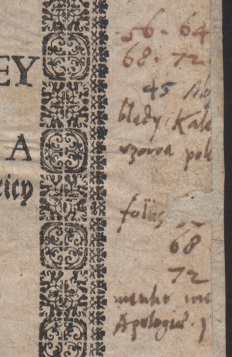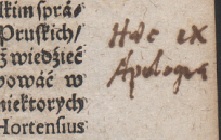One of the most amusing parts of reading through the vernacular sources related to the introduction of the Gregorian calendar in Polish-Lithuanian Commonwealth is the possibility to get a closer look at the rhetorical invention of the authors involved in this debate or, as you like, a quarrel. I am hoping to create a catalogue of such arguments, enthymems, metaphors, images and analogies, in the future; some of them are quite funny, some are annoying and embarassing (especially those which are openly xenophobic, anti-Ruthenian or anti-Semitic), but each of them plays an important role in the disquisitions of particular authors. The list of such rhetorical and dialectical devices will appear here in due course, meanwhile l would like to draw the readers’ attention to one particular phrase which has been haunting me for some time.
In the previous post on Joannes Broscius’s vain search for citations of his works in Jan Dubowicz’s thesis on the true (i.e. Gregorian) calendar, I referred to Broscius’s two apologies of the reformed calendar. His contribution to the calendrical debate in Poland-Lithuania should not be limited, however, to these two small Polish prints. There is actually one more brochure, which was published right before the two Apologies came of the Kraków and Warsaw printing presses and for a change was written in Latin.
The brochure in question is Broscius’s Sermo, which is a transcript or rather an elaborated, longer mutation of a sermon that our Kraków astronomer gave at the provincial synod of the Roman Catholic dioecese of Lutsk in Volhynia.

Let’s put aside the rhetorical structure of the whole address and arguments employed by the author and focus on one particular passage. In it, on fol. B2r, the stream of Broscius’s fluent Latin ornated with citations from the Scripture, Galen, Hippocrates, Aurelius Augustinus, Cardinal Bellarmin, is interrupted by an alien object:
… Nunquam ego illos esse vere Unitos, credam, nisi quemadmodum unus est Deus, una fides, unum baptisma, unum quoque nobiscum Pascha confiteantur et celebrent; reliquis vero temporibus simul nobiscum laborent, simul a laboribus quiescentes Sanctorum festa et memoriam devote recolant: ac ne illud rudes e plebe Rutheni usurpent: “Mnoho se Bohow narodiło”. Simul nobiscum Christo Domino e Virgine Sanctissimae nato, aurum, thus et myrrham offerant …
The phrase in quotation marks is an attempt to transcribe a Ruthenian quote with use of Latin alphabet and it means literally “Many Gods were born”.
 But what does this phrase actually mean? One could begin to wonder, whether perhaps it is some kind of theological or even, God forbid, cosmological thesis? Was Broscius a hidden follower of Giordano Bruno’s theory of the infinite number of worlds? Did he believe in the actual existence of numerous, parallel Earths with their own Jesuses, Bethlehems, Crucifixions and Resurrections. No matter how tempting this may seem and no matter how much one would like to see Broscius as a model for one of the protagonists of Umberto Eco’s fantasy on Baroque science, i.e. the 1994 novel The Island of the Day Before, or as an ancestor of Gottfried Wilhelm Leibniz or David K. Lewis, I must disappoint you – this is not the case. As far as I can tell, Broscius was neither of them. One should also rule out suppositions of some unknown kind of polytheism.
But what does this phrase actually mean? One could begin to wonder, whether perhaps it is some kind of theological or even, God forbid, cosmological thesis? Was Broscius a hidden follower of Giordano Bruno’s theory of the infinite number of worlds? Did he believe in the actual existence of numerous, parallel Earths with their own Jesuses, Bethlehems, Crucifixions and Resurrections. No matter how tempting this may seem and no matter how much one would like to see Broscius as a model for one of the protagonists of Umberto Eco’s fantasy on Baroque science, i.e. the 1994 novel The Island of the Day Before, or as an ancestor of Gottfried Wilhelm Leibniz or David K. Lewis, I must disappoint you – this is not the case. As far as I can tell, Broscius was neither of them. One should also rule out suppositions of some unknown kind of polytheism.
Nevertheless, the whole concept of the “plurality of Gods” adds some metaphysical spice to the Catholic-Uniate-Orthodox calendrical affair and takes the whole discussion to a new level, at least in the mind of an ontologically-sensitive reader. It is difficult to find either Broscius’s Sermo or in any other polemical writings some traces of reflection on what the actual liturgy and the liturgical year is. Yet, despite this lack of elaborated theory, there are bits and pieces of “folk theology” in which the liturgical year, with Christmas, Good Friday, Easter Sunday, Ascension and Pentecost is a cyclical, repetitive reenactment of the life of Jesus, in which the symbolic, commemorative sphere of liturgy and the actual life of Jesus are so close, that one could say that the events described in the Gospels actually take place in an annual cycle. And everything would go well if not the discrepancies between the two calendars. The use of two systems of measuring of time caused various problems on the high, social, theological, scientific level, but it had also its own representation in the popular culture and popular discourse of the time. The image of “many Gods” who “were born” and, to follow up, were crucified and resurrected a respective number of times, reflects up to a point the popular understanding of the conflict between the two calendars. Hence the paradoxical situation in which one (Catholic) Jesus is born in Bethlehem, while the other (the Uniate and Orthodox one) is still in Mary’s womb, or a parallell image in which the Catholic Jesus has already resurrected, while the Uniate/Orthodox is just on his way to Jerusalem (at least in these years when the delay of the Orthodox Easter amounts to 7 days). Although this reasoning is based on the reading of the liturgical commemoration in realistic terms, hence it qualifies as a logical fallacy, it makes a highly stimulating image which can easily appeal to one’s imagination.
Finally, one should ask about the origin of the whole phrase in question. Since it comes from the popular or folk discourse, it is difficult, if not impossible, to indicate a source or give credits to one, particular author. In this case, however, we are lucky as Broscius left us a note. One can find it in a sammelband that belonged to Broscius’s library and which contains three works by Peter Crüger, a Gdańsk/Danzig astronomer, correspondent of Broscius and teacher of Hevelius. In the sammelband (Kraków, Jagiellonian Library, shelfmark Mag. St. Dr. 54955−54957 II P), on the upper endleaf, there is a note in Latin which reads as follows:
Cum esset innovatum Calendarium alioque iam de Nativitatis Christi a Latinis celebraretur quam a Graecis Ruthenis quidam [?] camino quasi [?] dixit: Mnoho se Bohow narodiło Id audivi ab illustrissimo Domino Nicolau Pac Episcopio Samogitiae Patavii.
As much as helpful this note may be, it still leaves us on the level of the learned Catholics, as the informant of Broscius was not a Ruthenian nobleman or cleric, not to mention a servant or a peasant. The “Dominus Nicolaus” in question is Mikołaj Pac, the bishop of Samogitia (Żmudź), who travelled to Italy in the early 1620’s, met Broscius in Padua, and died in this city in 1624 at the age of 54. And since at our disposal we have only a reference to the oral testimony of a Catholic bishop who ruled the multiconfessional dioecese (Pac “dixit” Broscius), it is difficult, or even impossible, to tell whether it would be ever possible to track down the original roots of this concept. The Ruthenian phrase scribbled down by Broscius and incorporated into the printed text of the Latin Sermo of 1641 make the only two know occurences of this concept and I am not even sure if I should even expect finding more of them as my research moves forward. Despite these uncertainties, the image of „many Gods” remains a powerful and even witty concept which epitomizes well the conflict of two calendars under one roof of the 17th-century Polish-Lithuanian state.


 The second reason is the fact that Dubowicz’s book makes yet another link in the long chain of Latin, Polish and Ruthenian texts whose authors have been dealing with the issue of the introduction of the reform of calendar and its possible reception by the Uniates. This time we are having a text by an Uniate priest but we would not have chance to read it without Kasjan Sakowicz, a
The second reason is the fact that Dubowicz’s book makes yet another link in the long chain of Latin, Polish and Ruthenian texts whose authors have been dealing with the issue of the introduction of the reform of calendar and its possible reception by the Uniates. This time we are having a text by an Uniate priest but we would not have chance to read it without Kasjan Sakowicz, a  This annotation, or actually two separate ones, was slightly damaged due to the cutting of the entire volume, but we can certainly say that what Broscius had in mind were the errors of the Julian calendar (“błędy Kale[ndarza]”). After spending some time with books annotated by Broscius, I can say that he quite often limited his handwritten interventions to such lists which served the purpose of indexing the issues and passages important but weren’t necessarily followed by an extensive notes next to the actual fragment of printed text. In this case, references to pages 56, 64, 68 and 72 leave us only with Dubowicz’s text, while in case of a reference to p. 45, which was added in black ink, we find a Latin-Polish marginal note which says that the passage in question is treating about the “errores od Moskwy pokazowane”, “the demonstration of Moscow’s errors”.
This annotation, or actually two separate ones, was slightly damaged due to the cutting of the entire volume, but we can certainly say that what Broscius had in mind were the errors of the Julian calendar (“błędy Kale[ndarza]”). After spending some time with books annotated by Broscius, I can say that he quite often limited his handwritten interventions to such lists which served the purpose of indexing the issues and passages important but weren’t necessarily followed by an extensive notes next to the actual fragment of printed text. In this case, references to pages 56, 64, 68 and 72 leave us only with Dubowicz’s text, while in case of a reference to p. 45, which was added in black ink, we find a Latin-Polish marginal note which says that the passage in question is treating about the “errores od Moskwy pokazowane”, “the demonstration of Moscow’s errors”.


